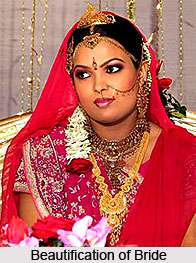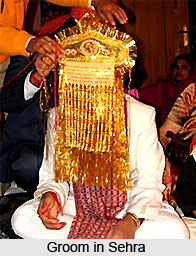 The most exciting moment for the bride and bridegroom in their marriage, is their own decoration or sajya. In every part of the world and in all religions, the bride is decorated and beautified to the utmost on this special day. The beautification of the couple is done to make them look attractive. Some races believe that the decoration should be done in a way, so that it has the power to avoid evil eye. In some tribes, it is believed that the bride should look as bad as ghosts, so that the ghosts also get frightened. However, in most of the clans, she is decorated to look beautiful.
The most exciting moment for the bride and bridegroom in their marriage, is their own decoration or sajya. In every part of the world and in all religions, the bride is decorated and beautified to the utmost on this special day. The beautification of the couple is done to make them look attractive. Some races believe that the decoration should be done in a way, so that it has the power to avoid evil eye. In some tribes, it is believed that the bride should look as bad as ghosts, so that the ghosts also get frightened. However, in most of the clans, she is decorated to look beautiful.
In India, among the Hindus, the bride is decorated with mehndi (turmeric paste), which is applied in artistic designs and patterns on her hands, Alia or a red coloured solution is applied on her feet. Black lamp or kajal is applied on her eyes to make it look large and bright. A small red disc type bindi is fixed on her forehead, heavy, gorgeous earrings are put in her ears and an ornament called nathh is put on her nose. Anklets dangle round her feet.
Before her beautification, she is rubbed with besan or gram dal paste in oil and then she takes a bath. Soon after, she is decorated with ornaments. She puts on stunning, fast colored clothes, usually red colored and sometimes green. In some regions, ivory bangles or chuda is a necessary ornament to put on.
 Around the waist, a girdle made of silver or gold is chained, which is called kandhoni.
Around the waist, a girdle made of silver or gold is chained, which is called kandhoni.
On the toes, small designed silver ornaments, called bichhua are also put on. The decoration is such as to cover up all exposed parts of the body of the bride. Since old times, she came out with a long covered head cloth over the face, but in the modern times, she has just covered the head with the face exposed. The decoration of the bridegroom is however, limited to applying mehendi on his hands and putting on a turban. The color of the turban is usually light red or pink. On the previous day, he is also given a thorough massage with Besan in oil.
The near relatives of the bridegroom, particularly the father, also put on pink colored turban.. Particularly among the tribes of central India, there is a system of tattooing over the body before marriage. This practice is common among African tribes. Among the tribes in northern India, Bihar or the south, this system does not exist. The bridegroom covers his face with a garland or sehra, which is a real gaudy one. His costume is ordinary and simple but eye catching. His jewellery is a ring or two on the fingers and a gold necklace, usually given by the bride`s father. Among the royal families, the bridegroom also puts on small jewel earrings.
More on Indian Marriage Customs
More on Indian Wedding Accessories
More on Indian Religious Weddings
More on Types of Marriages
See also
 The most exciting moment for the bride and bridegroom in their marriage, is their own decoration or sajya. In every part of the world and in all religions, the bride is decorated and beautified to the utmost on this special day. The beautification of the couple is done to make them look attractive. Some races believe that the decoration should be done in a way, so that it has the power to avoid evil eye. In some tribes, it is believed that the bride should look as bad as ghosts, so that the ghosts also get frightened. However, in most of the clans, she is decorated to look beautiful.
The most exciting moment for the bride and bridegroom in their marriage, is their own decoration or sajya. In every part of the world and in all religions, the bride is decorated and beautified to the utmost on this special day. The beautification of the couple is done to make them look attractive. Some races believe that the decoration should be done in a way, so that it has the power to avoid evil eye. In some tribes, it is believed that the bride should look as bad as ghosts, so that the ghosts also get frightened. However, in most of the clans, she is decorated to look beautiful.
 Around the waist, a girdle made of silver or gold is chained, which is called kandhoni.
Around the waist, a girdle made of silver or gold is chained, which is called kandhoni.

















